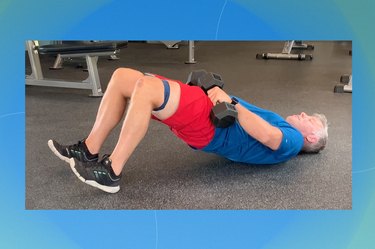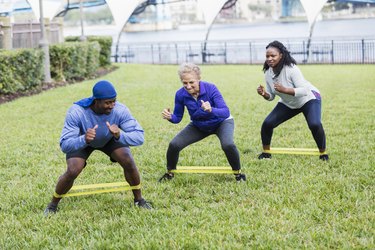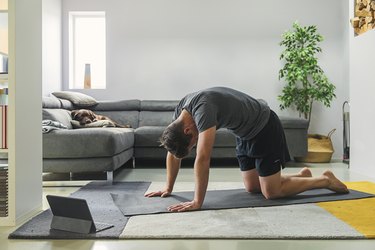
When you think about the dumbbell glute bridge, you might immediately think it's just a move young people do for the 'gram. Or that it's something people do to get a bigger butt (also maybe for the 'gram).
So, what if we told you it's a move that every adult should add to their healthy aging routine, too? In fact, according to some research, it's one of the best lower-body exercises you can do to maintain glute strength, power, mobility and stability as you age.
Video of the Day
Strong glutes help us do almost every activity in life, including walking, running, climbing stairs, carrying groceries and playing with your friends and family, says Pete McCall, CSCS, a certified strength and conditioning specialist, host of the All About Fitness podcast and author of Ageless Intensity: High-Intensity Workouts to Slow the Aging Process.
The bottom line: It doesn't matter if you're training for a triathlon after 50 or simply want to maintain strength and stability as you age, the loaded glute bridge can benefit everyone at every age. (Plus, it does also look great on the 'gram.)
How to Do the Dumbbell Glute Bridge
McCall recommends doing the loaded glute bridge two to three times per week as part of full-body strength training workouts.
To get started, do 2 to 3 sets of 15 to 20 reps, using medium weights. For each rep, focus on lowering slowly and quickly raising up. When 20 reps becomes somewhat easy, it's time to move to a heavier load, McCall says.
Dumbbell Glute Bridge
- Lie on your back with your arms resting by your sides, knees bent and feet flat on the ground, spread hip-width apart. Your feet should be close enough to your hips that if you reach one hand at a time toward each heel, you can just touch it with your fingertips.
- Place two dumbbells of equal weight vertically on top of your hip joints. Hold each in place.
- Squeeze your glutes and core, and press your heels into the ground to drive your hips up toward the ceiling until you form a diagonal line from knees to hips to chest.Resist the urge to arch your lower back as you raise your hips. Focus on keeping your spine in a neutral position throughout.
- Pause at the top, then slowly lower your hips back down to the ground.
Tip
Make the exercise more challenging by looping a mini resistance band around your thighs, just above your knees. This will increase how hard your glutes, especially your glute medius in the sides of your hips, has to work.
Why the Dumbbell Glute Bridge Is the Best Hip Exercise You Can Do for Healthy Aging
1. It Works Your Glutes (Hard)
"The dumbbell bridge places most of its load directly on the large glute muscles," McCall says.
And studies — including a 2017 study published in the Journal of Strength and Conditioning Research — have shown that hip extension exercises (like the bridge) may be better at strengthening the glutes compared with squats and deadlifts.
2. It's Easy on Your Knees and Back
Squats, lunges and maybe even deadlifts often come to mind when you think about how to work your hips. They're great go-tos, but they can place a decent amount of pressure on your lower back and knees, McCall says.
This can be aggravating for some people, especially because the knees and lower back can be hot spots as we age.
3. It's Great for At-Home Workouts
There definitely isn't a shortage of glute exercises out there to choose from, but the dumbbell glute bridge is great because you don't need any equipment other than a pair of weights. (You can make the move work with one if that's all you've got.)
4. It Fits All Strength Levels
Because the glute bridge is a lying, single-joint exercise, it doesn't require a ton of coordination to do, according to the Journal of Strength and Conditioning Research study.
Because you don't need expert-level coordination or core stability to do it with proper form, it's more accessible to people of all fitness levels.
5. It's More Accessible Than the Hip Thrust
When it comes to hip extension exercises, the hip thrust — which looks similar to the bridge, but involves balancing your upper back on a bench — usually gets all the glory. After all, it's great for loading up on the weight as you get stronger and also involves working your hips through a greater range of motion.
But not everyone belongs to a gym, and some people just want an alternative they can do at home. McCall also explains that, compared with the hip thrust, the glute bridge is much easier to set up and can be more comfortable on your upper back.
That means it's more feasible to do one, two or three times per week.






